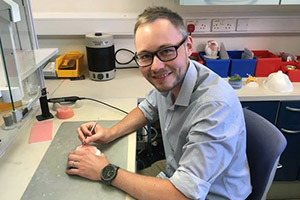Jim Dimond talks about Maxillofacial Prosthetics/Reconstructive Science
Jim is a Consultant Healthcare Scientist in maxillofacial prosthetics and service lead for maxillofacial prosthetics/reconstructive science at University Hospitals Coventry and Warwickshire NHS Trust.
- Programme
- STP
- Role
- Assessor
Why did you choose job/a career in healthcare science?
As a maxillofacial prosthetist (reconstructive scientist) I make and fit custom-made medical devices, such as facial prosthetics and metal skull plates. I wanted a practical profession as I’ve always enjoyed making things, but also wanted to work within healthcare. This clinical role is the best of both worlds.
What does a typical day involve?
Each day is very diverse. My time is split between sculpting wax and colouring silicone in the laboratory, taking moulds of patients and fitting prostheses and other devices in clinic, attending wards and theatre and digital 3D planning and printing using cutting edge technology. In addition, I could be called upon to plan emergency reconstruction of the facial bones after major trauma, or to make a splint to hold the jaws in the correct position.
How does your job impact on patient health?
The majority of patients we see have had major surgery and lost part of their face. Our role is to help rehabilitate them, giving them the confidence to return to everyday life and see family and friends without any concerns over their appearance. On top of the aesthetic benefits, we can also help with function following oral cancer, for example we can provide a modified denture to restore speech and swallowing. Pre-surgical planning is also a big aspect of what we do and this has helped to improve patient outcomes and reduce theatre time.
What would you say to someone thinking about a career in Healthcare Science?
A career in healthcare science is extremely rewarding. It is a privilege to be a part of the patient’s journey and to have such an impact on quality of life gives immense job satisfaction. Due to the range of work and materials used there is a lot to learn, but no two days are the same and certainly never boring.
